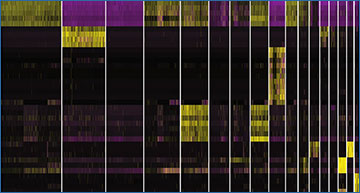Brain metastases is the most common intracranial tumor and account for approximately 20% of all systematic cancer cases. It is a leading cause of death in advanced-stage cancer, resulting in a five-year overall survival rate below 10%. Therefore, there is a critical need to identify effective biomarkers that can support frequent surveillance and promote efficient drug guidance in brain metastasis. Recently, the remarkable breakthroughs in single-cell RNA-sequencing (scRNA-seq) technology have advanced our insights into the tumor microenvironment (TME) at single-cell resolution, which offers the potential to unravel the metastasis-related cellular crosstalk and provides the potential for improving therapeutic effects mediated by multifaceted cellular interactions within TME.
Researcher at the Wake Forest University School of Medicine have applied scRNA-seq and profiled 10,896 cells collected from five brain tumor tissue samples originating from breast and lung cancers. Their analysis reveals the presence of various intratumoral components, including tumor cells, fibroblasts, myeloid cells, stromal cells expressing neural stem cell markers, as well as minor populations of oligodendrocytes and T cells. Interestingly, distinct cellular compositions are observed across different samples, indicating the influence of diverse cellular interactions on the infiltration patterns within the TME. Importantly, the researchers identify tumor-associated fibroblasts in both their in-house dataset and external scRNA-seq datasets. These fibroblasts exhibit high expression of type I collagen genes, dominate cell-cell interactions within the TME via the type I collagen signaling axis, and facilitate the remodeling of the TME to a collagen-I-rich extracellular matrix similar to the original TME at primary sites. Additionally, the researchers observe M1 activation in native microglial cells and infiltrated macrophages, which may contribute to a proinflammatory TME and the upregulation of collagen type I expression in fibroblasts. Furthermore, tumor cell-specific receptors exhibit a significant association with patient survival in both brain metastasis and native glioblastoma cases. Taken together, this comprehensive analyses identify type I collagen-secreting tumor-associated fibroblasts as key mediators in metastatic brain tumors and uncover tumor receptors that are potentially associated with patient survival. These discoveries provide potential biomarkers for effective therapeutic targets and intervention strategies.
Single-cell RNA-seq data analysis and cell annotation
a t-SNE plot of the profiled single cells. Cells with the same colors are from the same patient specimen. b t-SNE plot of the identified cell clusters. Different colors represent different cell clusters. c The heatmap shows the gene signatures of each annotated cell type. d t-SNE plot of the annotated cell types. Different colors represent different cell types. e Cell compositions of annotated cell types in each brain metastasis specimen.
Song Q, Ruiz J, Xing F, Lo HW, Craddock L, Pullikuth AK, Miller LD, Soike MH, O’Neill SS, Watabe K, Chan MD, Su J. (2023) Single-cell sequencing reveals the landscape of the human brain metastatic microenvironment. Commun Biol 6(1):760. [article]





